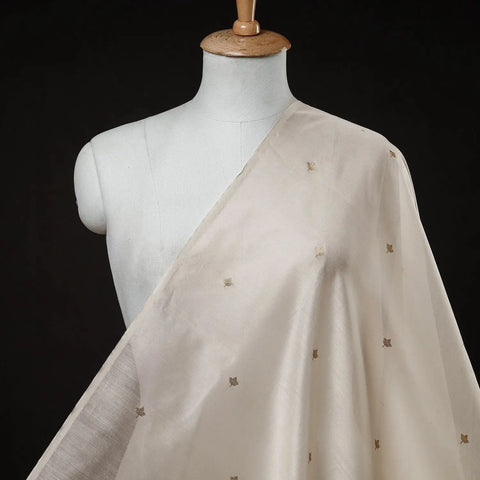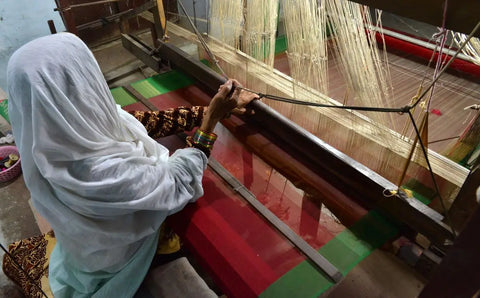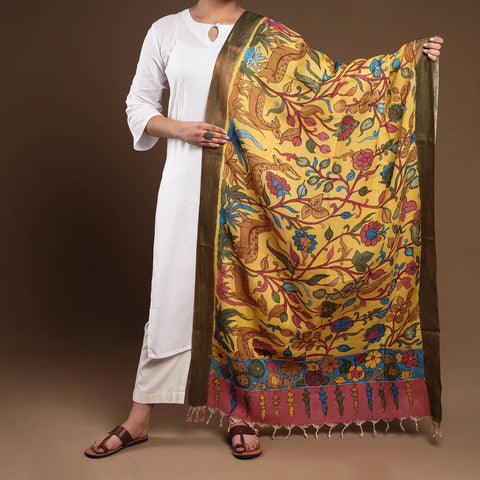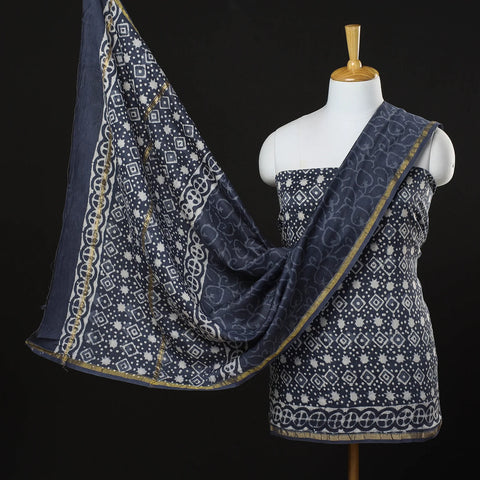Chanderi weaving is a timeless form of traditional Indian textiles that is renowned for its lightweight fabric, sheer and rich appearance and fine quality fibres. The sheer texture of the Chanderi fabric makes it mesmerising to look at and one of the first choices for any special occasion. Chanderi saree weavers are exceptionally skilled at handweaving and designing various Chanderi motifs onto pure silk, cotton silk or Chanderi cotton. They feature traditional peacock, floral and coin motifs that look incredible on the sheer fabric embellished by zari work. Have a look at the history and modern transformation of the Chanderi weave, what is Chanderi fabric and some amazing ways to style this fabric on special occasions!

History And Origin Of Chanderi Weaving
Mythologically, it is believed that the Chanderi weave can be traced back to the Vedic times and is said to be founded by Shishupal, Lord Krishna's cousin. Its origins can also be traced to the 7th century BC when it was handspun and woven to make turbans for the Maratha rulers. It became widely popular during the Mughal reign and was one of the favourite fabrics used to adorn the Queens. If you are wondering where does the traditional Chanderi saree come from, it gets its name from Chanderi, a town in Madhya Pradesh. When the 19th century began, there was a boom in industries and weavers switched to mill-made cotton for making Chanderi weaves. In 1910, the first golden embellishments and motifs on this Chanderi fabric were seen when it was brought under the patronage of the Scindia family. Its legacy is as huge and old as time and its glorious motifs and elegance are widely admired globally even today.
Process Of Chanderi Weaving
- Preparation of Yarn: The process begins when the yarn is carefully spun and then dyed in various vibrant colours. Usually, cotton and silk yarn fibres are used.
- Setting of Warp: Once ready. The warp yarns are ready to be set on the loom, which holds the threads vertically. The threads are arranged neatly to form the base of the fabric.
- Designing: The most important part is getting the various characteristics designs of the Chanderi weave right using hand-printed techniques. These motifs include florals, geometric patterns and more.
- Weaving: This part is where the traditional weavers show their magic and weave the fabric using handlooms to create the desired pattern. They need to create a balanced and consistent Chanderi weave, which proves to be an exceptionally demanding task.
- Embellishing: The fabric may undergo further embellishments such as zari work in gold, copper or silver colours depending on the design.
- Finishing: This step involves washing the fabric, starching it, and applying pressure to develop its drape and texture. This gives it a rich and polished finish.

Image Credit:- IndiaCurrents
Chanderi Weaving In Fashion Today
As much as Chanderi weaving is known for its rich traditional history, it has become a much sought-after fashion style and is in great demand for making sarees, dresses and other apparel. It looks amazing and is a versatile fabric, which is why it can be moulded into so many different modern styles.
Saree: Chanderi sarees are timeless, elegant and lightweight due to their sheer fabric. Their comfortable airy fabric and the eye-catching intricate motifs are the epitome of sophistication.
Dupatta: Chanderi dupattas are popular due to their beautiful versatility as they go well with all kinds of traditional and contemporary dresses. They have a sheer texture and soft feel that makes them look luxurious. From cotton to Chanderi silk dupatta, you can find a wide variety on iTokri.

Dress Material: Dress materials are a great gift for your loved ones, especially because they can design them the way they want to as per their liking. Chanderi dress material is even more striking and looks attractive with its Zari embellishments and motifs.

Stole: A newly popular accessory is the Chanderi stole, which can be paired with traditional and modern outfits alike. These lightweight stoles add a pop of colour and style to any look.
Care Of Chanderi Fabric
- You should avoid washing the fabric too often. If you must, use lukewarm or cold water to hand wash it or dry clean it.
- Dry the fabric in the shade as much as possible and avoid direct sunlight. This can cause fading and damage to the dye.
- As Chanderi fabric comes with embellishments, you should avoid ironing on those and always iron on medium to low heat.
- Store it in a cool and dry place to increase its longevity.
- Avoid spraying perfumes and other chemicals sprayed directly onto the fabric.
Conclusion
We hope your questions about where is Chanderi originated from, the types of Chanderi fabric and its influence in the fashion world today are answered. Chanderi is a gift given to us by history and we must relish it rightfully by preserving it in all its glory. We at iTokri believe in promoting India's rich heritage by supporting local skilled artisans and you can buy handwoven Chanderi fabric, sarees, dress material and more on our website. Get only the best quality handloom products directly from artisans on your favourite online handloom store, iTokri.
FAQs on Chanderi Weaving
1. What other dresses can be made with Chanderi fabric?
Chanderi fabric can be used to make sarees, dress materials, stoles, dupattas and more.
2. How is Chanderi fabric made?
The Chanderi fabric process involves several steps such as preparing yarn, warp setting, designing, weaving, embellishments and finishing.
3. Which yarn is used in Chanderi?
Silk or cotton silk yarn is used in Chanderi.
4. Chanderi weaving is from which state of India?
If you are wondering where is Chanderi, it is from a town in Madhya Pradesh known as Chanderi.
 Verified Purchase
Verified Purchase











































































































































































































Leave a comment (all fields required)